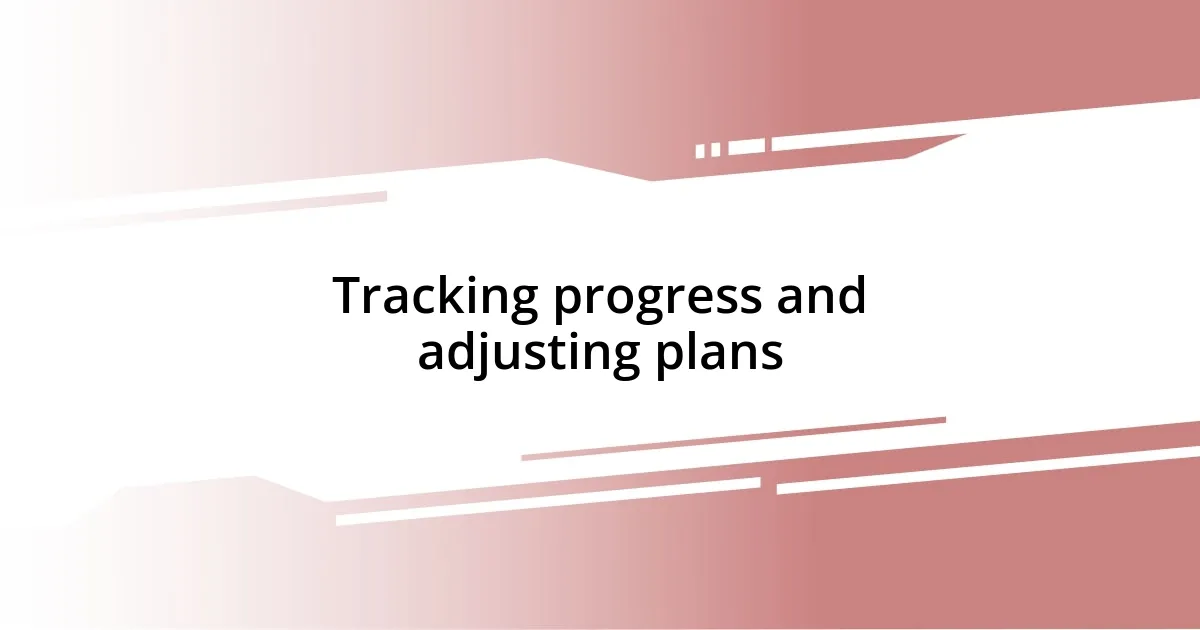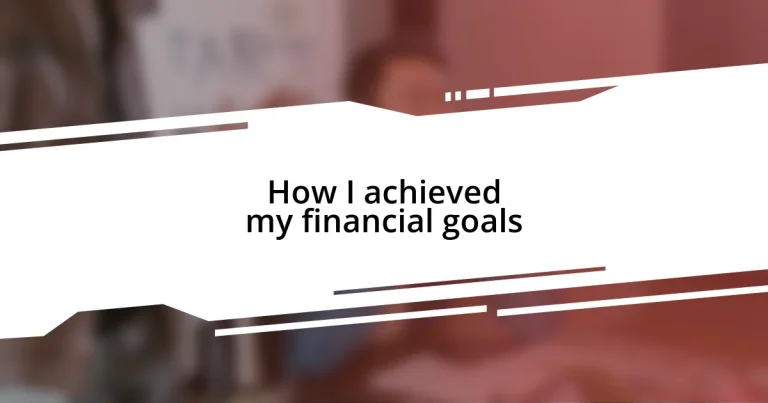Key takeaways:
- Establishing clear financial goals transforms aspirations into actionable objectives, making the path to financial freedom more defined.
- Creating a detailed budget and categorizing expenses brings clarity and enables effective tracking of spending and savings.
- Implementing saving strategies such as automatic transfers and the 50/30/20 rule helps balance spending while building savings.
- Regularly tracking progress and celebrating milestones fosters motivation and allows for adjustments to stay aligned with financial goals.

Understanding financial goals
Understanding financial goals goes beyond just figures and spreadsheets; it taps into our dreams and aspirations. I vividly remember my first encounter with budgeting, feeling overwhelmed by how much I wanted to save for that dream vacation. It struck me then—do I really know what I want my finances to achieve?
Setting financial goals is akin to plotting a course on a map; without clear destinations, the journey can feel aimless. I’ve often posed the question to myself: what does financial freedom really mean for me? For some, it’s about early retirement, while for others, it’s ensuring a safety net for their family. Defining that can ignite a fire in your efforts.
Reflecting on my experiences, I’ve learned that breaking down larger goals into bite-sized, measurable objectives can make the process less daunting. When I aimed to save a specific amount each month, I celebrated small wins along the way. It transformed not only my savings but also my mindset, turning what once felt like a chore into a series of achievable milestones. What small goals could you set today that might lead you closer to your bigger dreams?

Setting realistic financial objectives
Setting realistic financial objectives is essential for creating a roadmap to success. I initially launched my financial journey by dreaming big without considering the steps to get there. That led to a few frustrating months, where I felt like I was running in circles—I was motivated, but my goals didn’t align with my reality. I learned that ensuring my objectives were realistic took away the pressure and set me up for success.
What really helped me was creating a timeline for my goals. For instance, when I wanted to save for a new car, I didn’t just write down the figure; I figured out how much I could realistically set aside each month. This strategic planning made the goal feel less overwhelming. Every time I made a transfer into my savings, it became a small victory. Has setting a timeline ever helped you stay on track with your own goals?
Breaking down those larger aspirations into smaller, manageable targets brought a sense of accomplishment that fueled my motivation. Let’s say I aimed to save for a vacation in two years; I could set monthly savings goals. Each month, meeting those targets reassured me I was on the right path. Visualizing the journey as a series of smaller steps transformed my financial planning from a daunting task into an engaging challenge.
| Goal Type | Example |
|---|---|
| Short-term | Saving for a new gadget |
| Medium-term | Saving for a vacation |
| Long-term | Retirement savings |

Creating a detailed budget plan
Creating a detailed budget plan is a game-changer in reaching financial goals. I remember the moment I sat down with a notepad and actually mapped out my expenses. It was eye-opening! By categorizing my spending—like groceries, entertainment, and savings—I gained clarity on where my money was going. That realization helped me pinpoint areas ripe for savings.
To create an effective budget plan, I recommend the following steps:
- List all income sources: Write down every penny that comes in, including side hustles and freelance work.
- Track your expenses: Use apps or spreadsheets to record your spending over a month.
- Categorize expenses: Divide them into fixed (like rent) and variable (like dining out).
- Set realistic limits: Allocate a maximum amount for each category based on your spending habits and financial goals.
- Review and adjust regularly: Life changes, and so should your budget. Check in monthly to see if adjustments are needed.
It’s fascinating how these small habits can lead to significant financial changes. I recall feeling stressed about money management, but breaking it down into categories transformed that anxiety into empowerment. It made my financial journey feel more tangible, and celebrating the little victories, like reducing my dining out budget, made a huge difference in my overall outlook. What have you realized about your spending habits that could enhance your budgeting process?

Implementing effective saving strategies
Implementing effective saving strategies has truly been a breakthrough moment for me. One approach that worked wonders was automating my savings. I set up a direct transfer each payday, so a portion of my income went straight into my savings account before I even had a chance to spend it. It’s like developing a financial muscle memory—once I got used to living on a little less, I found the process effortlessly seamless. Have you tried automating your savings?
Another strategy I found useful was the 50/30/20 budgeting rule. In my case, I allocated 50% of my income for needs, 30% for wants, and 20% directly to savings. At first, sticking to these percentages felt restrictive, but soon enough, I found creative ways to enjoy my ‘wants’ while still building my savings. For instance, I started exploring inexpensive hobbies, like hiking, which not only saved money but enriched my life. How do you balance spending and saving in your own budget?
Being mindful of my spending habits also played a pivotal role in my saving journey. I began tracking my expenses closely to identify unnecessary purchases, and it was eye-opening. One small change—dining out less frequently—allowed me to save hundreds that quickly added up. It wasn’t about deprivation; it was about prioritizing what truly brought joy and aligning my spending with my values. Do you have spending habits that could use a little reevaluation?

Investing for long-term growth
Investing for long-term growth has been one of the most transformative decisions I’ve made in my financial journey. When I first dipped my toes into the world of investing, I felt a mix of excitement and fear. I remember scrolling through stock prices, trying to grasp the trends and terminologies. It seemed overwhelming at first, but the thrill of watching my investments grow over time became incredibly motivating. Have you ever felt that rush after making a wise investment?
One strategy I embraced was focusing on index funds. They offer diversification, which was comforting to me as a novice. I started with small contributions, probably less than I spent on coffee each week, and gradually increased my investment as my confidence grew. It’s astonishing how compounding works—seeing my modest beginning blossom into something significant felt like a gradual miracle. Have you discovered a particular investment vehicle that resonates with you?
I often remind myself that patience is key in investing. There were times when market fluctuations made my stomach churn, but I learned to view those moments as opportunities rather than threats. I recall a particularly volatile period when my investments dipped, and instead of panicking, I chose to educate myself more about market trends and history. Understanding that markets recover over time has kept me grounded. What strategies or resources do you turn to when you feel uncertain about your investments?

Tracking progress and adjusting plans
Tracking progress in my financial journey was a game-changer for me. I started by setting clear, measurable goals—like aiming to save a specific amount each month. Every milestone, whether big or small, was a reason to celebrate, and it kept me motivated to push further. How do you measure your financial success?
Adjusting my plans based on my progress became essential as well. After a few months, I noticed my initial goals were either too ambitious or not ambitious enough. For example, I realized my spending on groceries was consistently lower than my budget, so I shifted those funds toward savings for a planned vacation. This flexibility allowed me to stay engaged with my financial goals while ensuring I was making the most out of my situation. Have you ever revisited your financial plans for better alignment with your actual spending?
Regularly reviewing my expenses and savings also brought clarity to my journey. I developed a habit of conducting a monthly check-in, where I would assess my progress and make adjustments as needed. During one of these sessions, I discovered that my entertainment expenses had crept up, prompting a quick rethink on how to enjoy life without overspending. It’s all about finding that sweet spot between enjoying the present and securing the future—what adjustments have you found beneficial in your financial tracking?

Celebrating milestones and planning ahead
Celebrating milestones is like adding fuel to my financial fire. A few years ago, I reached my first significant savings goal—$10,000 in my emergency fund. I distinctly remember treating myself to a nice dinner, feeling a wave of relief wash over me. It was a reminder that my efforts were paying off. Do you feel a sense of accomplishment when you reach your financial targets?
Looking ahead, I’ve learned to set new goals that challenge me while also feeling attainable. For instance, after hitting my emergency fund milestone, I decided to aim for a down payment on a house. This fresh target filled me with determination, pushing me to think creatively about income sources and budgeting. What’s your next big goal, and how do you plan to get there?
The future often feels uncertain, but reflecting on past successes helps me stay optimistic. Each celebration of a milestone serves as a stepping stone, adding layers of confidence and strategy for the upcoming financial goals. I’ve come to appreciate the journey as much as the destination, which fuels my enthusiasm to plan ahead. How do you envision your financial landscape evolving in the years to come?














